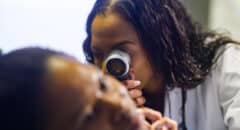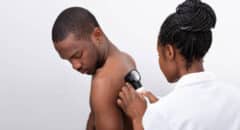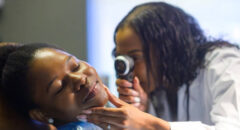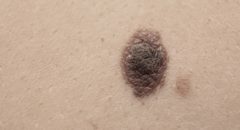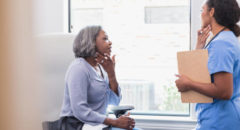 Who's got your back? That's one of the most important questions you can ask this summer and the title of a recent survey on sunscreen habits from the American Academy of Dermatology (AAD). Results of AAD's survey show that the majority of people don’t regularly apply sunscreen to their backs or check the skin on their backs for signs of skin cancer.
Who's got your back? That's one of the most important questions you can ask this summer and the title of a recent survey on sunscreen habits from the American Academy of Dermatology (AAD). Results of AAD's survey show that the majority of people don’t regularly apply sunscreen to their backs or check the skin on their backs for signs of skin cancer.
Melanoma is the most dangerous form of skin cancer, and Blacks have the highest mortality rate from melanoma. So, how do we protect ourselves? Lauren Ploch, MD, FAAD, a board-certified dermatologist, recently spoke with BlackDoctor.org about the survey, skin cancer detection and the ABCDEs of inspecting the skin for melanoma.
BDO: What does the survey tell us about our skin protection habits, in general?
Dr. Ploch: The survey told us that thirty-seven percent of us rarely or never apply sunscreen to our backs when they're exposed to the sun, and that forty-three percent of us rarely or never ask someone to help us apply sunscreen to our back before we go out in the sun. It also told us that fourteen percent of us, if no one was around to help us apply sunscreen, fourteen percent of us wouldn't take any action, such as staying inside, staying in the shade, or protecting ourselves with sun-protective clothing when going out in the sun.
BDO: So now, with all the places on our bodies, of course we need sunscreen all over head to toe, but why is the back so important?
Dr. Ploch: The back is the most common location of melanoma and one of the most common locations of all types of skin cancers. And, it's an area that we often forget about because it's not something that we see on a regular basis. So, it's really important to protect ourselves there. It's also important to look at our backs or have someone help us look at our backs on a regular basis to see if there's anything that's kind of funny looking or anything that's changing over time.BDO: Who was included in the study? Was it a mix of men and women? Is it a mix of different races? Different ages?
Dr. Ploch: It was a mix of different sexes, men and women, different races, different ages. The ages ranged from eighteen to sixty-four. It was a national survey, so everyone was invited to participate. We did find that men are a little less vigilant than women in terms of sun protection. They were a little less likely to apply sunscreen to their back and less likely to ask someone to help them apply sunscreen to their back. They were also more likely to be uncomfortable asking someone to apply sunscreen to their back than women were. So, it's interesting to see the difference between men and women.
BDO: In the study were there particular findings broken out specifically for African Americans?
Dr. Ploch: Not yet, but we do know that African Americans are affected by melanoma. African Americans have a higher mortality rate from melanoma than Caucasians do and we're not sure if it's because they're particularly affected with more aggressive types of melanoma or if there are delays in detection and treatment, because a lot of people with darker skin types think that they're not quite as prone to skin cancer but we're all prone to skin cancer regardless of our skin color.
BDO: What should people look for when checking their skin or looking for signs on other people? What are the signs of skin cancer we should be looking for?
Dr. Ploch: So, it's really important to look at least once a year and get someone involved to help you. The American Academy of Dermatology study did show that while fifty-seven percent of us know how to check for skin cancer, only fifty percent of us do it on an annual basis, and only thirty-six percent of us look at our backs to look for skin cancer. Now, the things you want to look for are things that are changing, growing, bleeding, itching - changing in any way. A good way to keep track of that is to take photos or you can download a mole map at SpotSkinCancer.org, and you can put your moles on the diagram and track them over time so you can see from one year to the next if there's anything new or if anything has grown. I do recommend to my patients that they measure their moles and take photos to document them.
Now, some of the things that you want to look for are the A-B-C-D-E's of melanoma. A is for 'Asymmetry'. That's where one side looks different than the other. B is for 'Border irregularity' where the borders are blurred or notched. C is for 'Color', so if there's multiple colors or if the color's not consistent that's a concern. D is for 'Diameter' so anything larger than a small pencil eraser, which is about 6mm, should be checked. And E is for 'Evolving' and that goes back to change. If something is changing in size, shape or color, or if it's starting to bother you in some way, like itching or bleeding, it's important to have it checked by a dermatologist.BDO: Let's say you don't happen to have any sunscreen around - maybe you're just stepping out for lunch really quickly or something like that - are there alternatives to sunscreen that can keep you protected temporarily?
Dr. Ploch: Well, nothing's as good as sunscreen, but obviously there are times where you may be without it. It's important to wear sun-protective clothing. So, if you have access to a hat, or an umbrella, or a long-sleeve shirt, long pants, sunglasses are very important. Also, try to stay in the shade as much as possible. The shade doesn't truly protect us from the UV rays, but we do get some protection. Stay indoors if you can, especially when the sun's rays are strongest between the hours of 10 a.m. and 2 p.m. So, those are all things that can be done to kind of help us with sun protection when we don't have sunscreen. But, sunscreen is so readily available, I tell all my patients keep one at home, keep one in the car, keep one at the gym; if they play any outdoor activities keep one in your golf bag or your gym bag because it's just so readily available. Sunscreens are relatively inexpensive. You can find something great over-the-counter that's broad spectrum and that's at least SPF 30 and that says water resistant on it for relatively inexpensive.
BDO: And SPF 30, at a minimum, that's what we should look for?
Dr. Ploch: At a minimum SPF 30. Really the key is re-application with sunscreen. So, the number doesn't matter as much if you're re-applying it every hour to hour and a half, even two hours when you're outdoors.
For more information, visit SpotSkinCancer.org.



